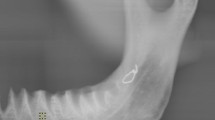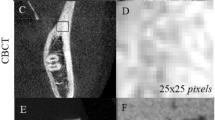Abstract
Objectives
To determine the conversion value of grayscale density measurements from intraoral conventional radiographic examinations of the edentulous maxilla and mandible using intraoral digital radiography.
Methods
Periapical radiography examinations with a pararelling technique, both conventional and digital, were performed on 18 male and 34 female patients with edentulous maxillas and mandibles. The trabecular bone pattern of 42 maxillary and 61 mandibular regions of interest (ROIs) was classified into five grades. Grayscale density measurements were made within a marked area of the ROI in the image of the periapical digital radiograph in the same corresponding trabecular region. To obtain conversion values, including the effects of age, gender, and region of the jaw, an analysis was made to develop regression equations.
Results
The kappa value for intra- and interobserver differences was 0.71–0.85. The strength of the radiographic conventional value to predict the grayscale density measurement of digital radiography was gained from the regression analysis, with R 2 = 0.75–0.8. The regression equation for the maxilla and the mandible were separated, and the age, gender, and region of the jaws were included.
Conclusions
Conventional intraoral radiographic values of the trabecular bone pattern can be converted to values of grayscale density measurements from intraoral digital radiography. The regression equation for the conversion was obtained by including the effects of age, gender, and region of the jaw.



Similar content being viewed by others
References
White SC, Pharoah MJ. Oral radiology: principles and interpretation. 5th ed. St. Louis: Mosby; 2004. pp. 71–120, 225–77, 314–29, 677–91.
Whaithes E. Essentials of dental radiography and radiology. 3rd ed. London: Churchill Livingstone; 2007. p. 289–97.
Mupparapu M, Sinner SR. Implant imaging for the dentist. J Can Dent Assoc. 2004;70(1):32.
Berkhout WER, Sanderink GCH, van der Stelt PF. Does digital radiography increase the number of intraoral radiographs? A questionnaire study of Dutch dental practices. Dentomaxillofac Radiol. 2003;32:124–7.
van der Stelt PF. Filmless imaging: the uses of digital radiography in dental practice. JADA. 2005;136:1379–87.
Parks ET, Williamson GF. Digital radiography: an overview. J Contemp Dent Pract. 2002;3(4):23–39.
Yoshiura K, Welander U, David WM, Li G, Shi X-Q, Nakayama E, et al. Comparison of the psychophysical properties of various intraoral film and digital systems by means of the perceptibility curve test. Dentomaxillofac Radiol. 2004;33:98–102.
Taguchi A, Tanimoto K, Akagawa Y, Wada T, Rohlin M. Trabecular bone pattern of the mandible: comparison of panoramic and CT. Dentomaxillofac Radiol. 1997;26:85–9.
Taguchi A, Tanimoto K, Suei Y, Otani K, Wadamoto M, Akagawa Y, et al. Observer agreement in the assessment of mandibular trabecular bone pattern from panoramic radiographs. Dentomaxillofac Radiol. 1997;26:90–4.
Altman DG. Practical statistic for medical research. 1st ed. London: Chapman and Hall; 1991. p. 403–9.
Ulm C, Tepper G. Structure of atrophic alveolar bone. In: Georg W, editor. Implants in qualitatively compromised bone. London: Quintessence; 2004. p. 29–31.
Misch CE. Contemporary implant dentistry. 2nd ed. St. Louis: Mosby; 1999. p. 73–118.
Nanci A, Whitson SW, Blanco P. Bone. In: Nanci A, editor. Ten Cate’s oral histology, development, structure, and function. 6th ed. St. Louis: Mosby; 2003. p. 111–44.
Neukam FW, Kloss FR. Compromised jawbone quantity and its influence on oral implant placement. In: Zarb G, Lekholm U, Albrektsson T, Tenenbaum H, editors. Aging, osteoporosis and dental implants. Chicago: Quintessence; 2002. p. 67–84.
Mundy GR. Bone resorbing cells. In: Favus MJ, editor. Primer on metabolic bone diseases and disorders of mineral metabolism. 2nd ed. New York: Raven Press; 1993. p. 25–32.
Prentice A, Schoenmakers I, Laskey MA, de Bono S, Ginty F, Goldberg GR. Nutrition and bone growth and development. Proc Nutr Soc. 2006;65(4):348–60.
Author information
Authors and Affiliations
Corresponding author
Rights and permissions
About this article
Cite this article
Priaminiarti, M., Utomo, B., Susworo, R. et al. Converting conventional radiographic examination data of trabecular bone pattern values into density measurement values using intraoral digital images. Oral Radiol 25, 129–134 (2009). https://doi.org/10.1007/s11282-009-0024-y
Received:
Accepted:
Published:
Issue Date:
DOI: https://doi.org/10.1007/s11282-009-0024-y




